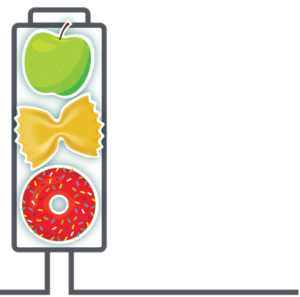Program Overview
The Food Bank’s Nutrition team works to empower our community with the knowledge and resources to make healthy, budget-friendly choices when accessing food assistance. Through innovative programs and partnerships, we connect neighbors with the tools they need to improve their overall health and well-being.
Prescription Pantry Program
The Prescription Pantry Program is a partnership between the Food Bank and healthcare providers who identify patients whose health would benefit from improved access to nutritious food. Participants receive a “prescription” for healthy groceries such as fresh fruits and vegetables, lean proteins, and whole grains, along with recipes and cooking tips. Many participants are managing diet-related illnesses such as diabetes or heart disease, so the program emphasizes foods that can help stabilize blood sugar, support heart health, and improve overall wellness. By combining the expertise of medical providers with the resources of the Food Bank, Prescription Pantry bridges the gap between healthcare and hunger relief, making good nutrition an integral part of treatment and recovery.

SWAP (Supporting Wellness at Pantries)
Our SWAP program, or Supporting Wellness at Pantries, uses a simple stoplight-style nutrition ranking system that makes it easier for neighbors to choose healthier food options when visiting our partner pantries. Foods are categorized as green for “choose often,” yellow for “choose sometimes,” and red for “choose rarely” based on levels of saturated fat, sodium, and added sugars. This easy-to-understand system helps families make informed choices that support long-term health and aligns with our goal of reducing the risk of chronic disease in the communities we serve.
GREEN – CHOOSE OFTEN
Low in saturated fat, sodium, and added sugar; supports health
Some examples of GREEN foods include:
-
All fresh fruits and vegetables
-
Whole eggs
-
Whole grain bread, pasta, tortillas
-
Brown rice
-
Skim, 1%, and 2% milk
-
Plain water, coffee, and tea
YELLOW – CHOOSE SOMETIMES
Moderate levels of fat, sodium, or added sugar; can contribute to good health
Some examples of YELLOW foods include:
-
100% fruit juice
-
Regular “white” bread, pasta, tortillas
-
White rice
-
Whole milk
-
Most peanut butter
-
Plain dried fruit such as raisins
RED – CHOOSE RARELY
High levels of fat, sodium, or added sugar; think of as treats; limited health benefits
Some examples of RED foods include:
-
Desserts such as ice cream, cookies, cake
-
Candy
-
Most processed / packaged snacks
-
Regular soda and juice drinks
 SWAP was developed by the Institute for Hunger Research & Solutions at Connecticut Foodshare.
SWAP was developed by the Institute for Hunger Research & Solutions at Connecticut Foodshare.
Nutrition on Wheels at Distributions
Nutrition on Wheels, or NOW, brings nutrition education directly to the community through brief nutrition lessons at Mobile Harvest and Produce on Wheels sites. These events offer interactive demonstrations, tips for cooking on a budget, and information about healthy food choices. Currently, NOW is on hold, but occasional pop-ups may still take place at Mobile Harvest and Produce on Wheels locations when possible, and the program will return in full when resources allow.
For more information about the Food Bank’s nutrition programs, please contact director of programs, Sarah Sanchez, at (775) 331-3663 ext 147.







 SWAP was developed by the Institute for Hunger Research & Solutions at Connecticut Foodshare.
SWAP was developed by the Institute for Hunger Research & Solutions at Connecticut Foodshare.


